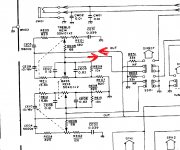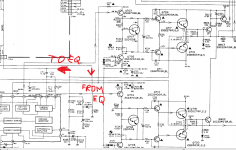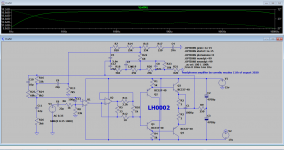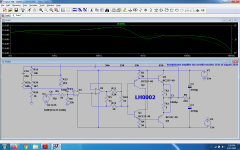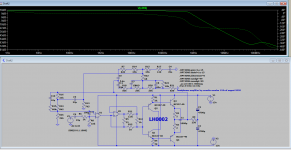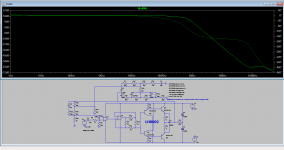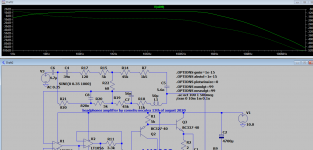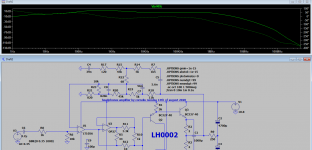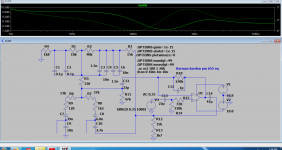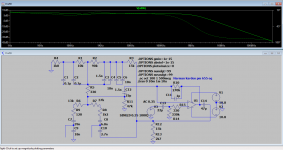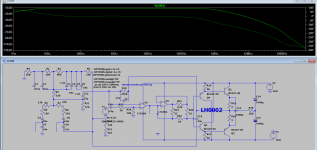Would anyone help me with some design rules to apply a baxandall tone stack in the feedback loop of a headphones amp with a gain of 10...20x?Both inverted and noinverted popology would be considered.
Try this; it may bring useful information to you.
Baxandall active tone stack site😱rg - Google Search
Baxandall active tone stack site😱rg - Google Search
i've seen them already...everything i read on the subject is about unity gain circuits...nothing on amplifiers with a gain >1
As in an active Baxandall tone stack the impedances at both potentiometer sides are equal in linear position, you can't design an amplifier with more than unity gain, unless you provide a 2nd stage.
Best regards!
Best regards!
A gain of 40 dB in linear position of both potentiometers with just one opamp? Barely believable.
Best regards!
Best regards!
You will spend $10 on pots, PCB and various components and some 40 cents on a dual Op Amp so just use one, period, no point in avoiding it.there are few amps that do it for 100x gain...
Meaning: build a classic Baxandall tone control and insert it between Music source and your choice of final amplifier.
Harman kardon 645, Marantz PM62, Kenwood KA-1000 and that's just the amplifiers that i owned and i know ...A gain of 40 dB in linear position of both potentiometers with just one opamp? Barely believable.
Best regards!
Well, the Harman Kardon doesn't feature an active Baxandall tone stack. Look at the pots' both sides: There are components of different values, aren't they?
Best regards!
Best regards!
It's Baxandall all the way so each side of the tone stack needs to be adjusted with the feedback network's gain somehow...I just don't know the math behind it.
As i hardly get useful input here, i'll just show some simulations i did with the marantz pm62 circuit and some minor mods on a 10...20x gain stack because i'm going to use its model for my first experimentations of my last headphones amp based on technics AA buffer...the nonlinearity with the pots half way is 0.5...0.7db around 1...2khz
I already used on more op-amp(actually both sections of each op-amp in parallel in each channel) in the headphones amp and given the bass lack of lm6172 i'm going to use in it, i simply wanted to have it all in one go. I'll probably try other networks too cause i'd really like to have a full bass-midle-high tone stack to be honest as i'm coupling it with a phono preamp, although the other option would be to have the bariable riaa feedback in the mids area.
I would have liked to have more theoretical positive input though...
I already used on more op-amp(actually both sections of each op-amp in parallel in each channel) in the headphones amp and given the bass lack of lm6172 i'm going to use in it, i simply wanted to have it all in one go. I'll probably try other networks too cause i'd really like to have a full bass-midle-high tone stack to be honest as i'm coupling it with a phono preamp, although the other option would be to have the bariable riaa feedback in the mids area.
I would have liked to have more theoretical positive input though...
Attachments
> Google , there's no audio
The "Baxandalls" you are citing were not in Bax's paper.
If you build a James (passive), with 10:1 loss, but install it "backward" inside a NFB loop, you get a gain near 10 and almost +/-20dB shelves.
The pot taper is, not "Audio", but "Reverse Audio", unless you accept knobs turning "backward". (Quad did this by recessing the knob; Dynaco just ordered RevAud pots.)
The NFB stability of the amplifier is VERY critical because the NFB network can add phase shift over a wide range.
The "Baxandalls" you are citing were not in Bax's paper.
If you build a James (passive), with 10:1 loss, but install it "backward" inside a NFB loop, you get a gain near 10 and almost +/-20dB shelves.
The pot taper is, not "Audio", but "Reverse Audio", unless you accept knobs turning "backward". (Quad did this by recessing the knob; Dynaco just ordered RevAud pots.)
The NFB stability of the amplifier is VERY critical because the NFB network can add phase shift over a wide range.
The 'math' is simply that you voltage-divide the NFB before feeding it back, so as to get the required gain. Have a look at the Quad 33 for example.
Thank you both for your answers!I never knew that making it passive it belongs to James...I can find a lot more info on that, including PRR interventions on other sites.
i simmd the phase shift to 500mhz and it doesn't look too bad...but im going to try more simulations with more networks to understand how they work as my math was always a weak spot...>
The NFB stability of the amplifier is VERY critical because the NFB network can add phase shift over a wide range.
To be honest i don't understand this part...but some good amps used it , some of them being very good ones like Kenwood KA-1000 although i saw its reviews and it stated that with one of the three turnover controls the output level changed wildly, everything else being fine with the rest of controls.It's clearly something i'm more interested in learning how it's done, especially because i make a lot of phono preamps working with higher than normal supply rails and having the feedback network embedded in the power amp's network looks like the best approach.> Google , there's no audio
The pot taper is, not "Audio", but "Reverse Audio", unless you accept knobs turning "backward". (Quad did this by recessing the knob; Dynaco just ordered RevAud pots.)
Attachments
Last edited:
I'm honestly not a major fan of the "tone controls in feedback loop" approach. For one thing they always tend to be a compromise in noise performance and give somewhat funky tone control characteristics as well, and then you need special reverse log pots (-16 dB at 12 o'clock, typ, called either C or G I think).
It's a circuit overall much more attractive to large-scale manufacturers than DIY folks.
I'd just include a classic inverting Baxandall at line level (with a buffer if need be) and be done with it.
It's a circuit overall much more attractive to large-scale manufacturers than DIY folks.
I'd just include a classic inverting Baxandall at line level (with a buffer if need be) and be done with it.
Funky tone for funky music 🙂
The Jimmy Castor Bunch - It's Just Begun - YouTube
Just checked the controles at the extremes with my minor modes for lower gains and the original +-6db changed to +-2db...so its action became softer, but the 0.7db deep i got around 1khz is not very encouraging with the halfway pot.
Also the treble 10kz action is needed with most headphones so my app would be somehow failled with a softer action.
I have enough anti-log pots as i still have those scrapped amps (karman kardon and marantz).I have to admit that i am really reconsidering the unity gain baxendall but i want to learn more on this type of eq.I had once the ka-1000 which was a truly high end amp so maybe it's not exactly the worst idea to have the tone controls in the feedback loop yet it needs to be properly implemented with the amp's actual gain.
Well the ka-1000 gad the tone defeat switch too 🙂
The Jimmy Castor Bunch - It's Just Begun - YouTube
Just checked the controles at the extremes with my minor modes for lower gains and the original +-6db changed to +-2db...so its action became softer, but the 0.7db deep i got around 1khz is not very encouraging with the halfway pot.
Also the treble 10kz action is needed with most headphones so my app would be somehow failled with a softer action.
I have enough anti-log pots as i still have those scrapped amps (karman kardon and marantz).I have to admit that i am really reconsidering the unity gain baxendall but i want to learn more on this type of eq.I had once the ka-1000 which was a truly high end amp so maybe it's not exactly the worst idea to have the tone controls in the feedback loop yet it needs to be properly implemented with the amp's actual gain.
Well the ka-1000 gad the tone defeat switch too 🙂
Last edited:
comments on the way...
Attachments
-
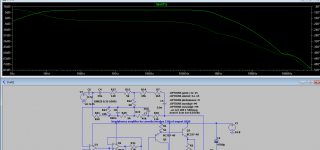 500mege.png45.8 KB · Views: 52
500mege.png45.8 KB · Views: 52 -
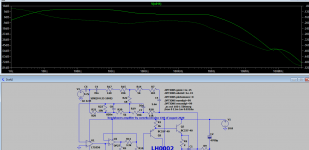 500megd.png51.8 KB · Views: 51
500megd.png51.8 KB · Views: 51 -
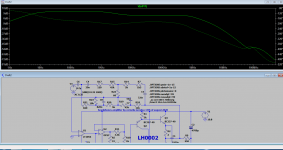 500megc.png59.3 KB · Views: 54
500megc.png59.3 KB · Views: 54 -
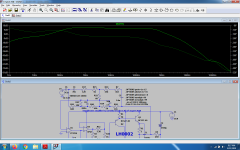 500megb.png145.7 KB · Views: 52
500megb.png145.7 KB · Views: 52 -
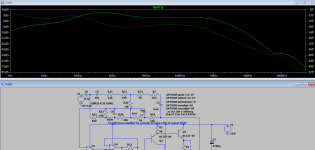 500mega.png46.3 KB · Views: 48
500mega.png46.3 KB · Views: 48 -
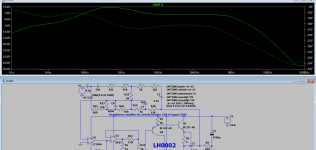 100mega.png50.1 KB · Views: 54
100mega.png50.1 KB · Views: 54 -
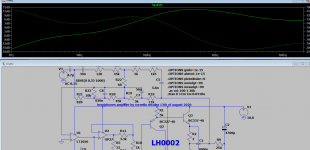 headphoneslh0002bothhalfway.png56.5 KB · Views: 45
headphoneslh0002bothhalfway.png56.5 KB · Views: 45 -
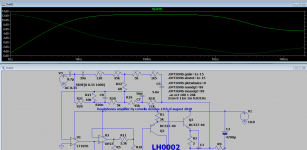 headphoneslh0002-6.5db 10khz.png52.9 KB · Views: 52
headphoneslh0002-6.5db 10khz.png52.9 KB · Views: 52 -
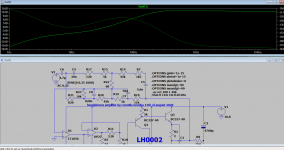 headphoneslh0002-5db 100hz.png59 KB · Views: 54
headphoneslh0002-5db 100hz.png59 KB · Views: 54 -
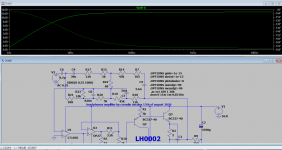 headphoneslh0002-0db.png63.7 KB · Views: 58
headphoneslh0002-0db.png63.7 KB · Views: 58
They don't look like indians to me 😉
I used the marantz pm62 tone stack with some minor modifications to adjust to a gain of 12x
I think i like what i can get with this kind of setup to be honest as this type of equalizer is very efective on the mids too.It's not very user friendly , especially not the kind of eq you'd like to have on a mixing console, but it looks like doing a great job honestly.
There was indeed some instability around 80Mhz in the inverting topology which was easily cured with a small inductor between 22uH...100uH
No such instability in the noninverting topology which also came with a better SNR of about 10db at 100hz, yet no big difference at 1khz and it's around -80db at the highest output volume anyway...
I used the marantz pm62 tone stack with some minor modifications to adjust to a gain of 12x
I think i like what i can get with this kind of setup to be honest as this type of equalizer is very efective on the mids too.It's not very user friendly , especially not the kind of eq you'd like to have on a mixing console, but it looks like doing a great job honestly.
There was indeed some instability around 80Mhz in the inverting topology which was easily cured with a small inductor between 22uH...100uH
No such instability in the noninverting topology which also came with a better SNR of about 10db at 100hz, yet no big difference at 1khz and it's around -80db at the highest output volume anyway...
Attachments
Last edited:
I thought that maybe the more complex harman kardon tonestack they use with a gain of around 6x will be better, but this is the best linear response between 100hz and 1khz it delivered without any modification....The response up to 500mhz looks more linear than the marantz pm 62, but the noise is a lot higher .at just half the gain...
Attachments
- Home
- Amplifiers
- Solid State
- Baxandall active tone stack applied to headphones amplifier?
